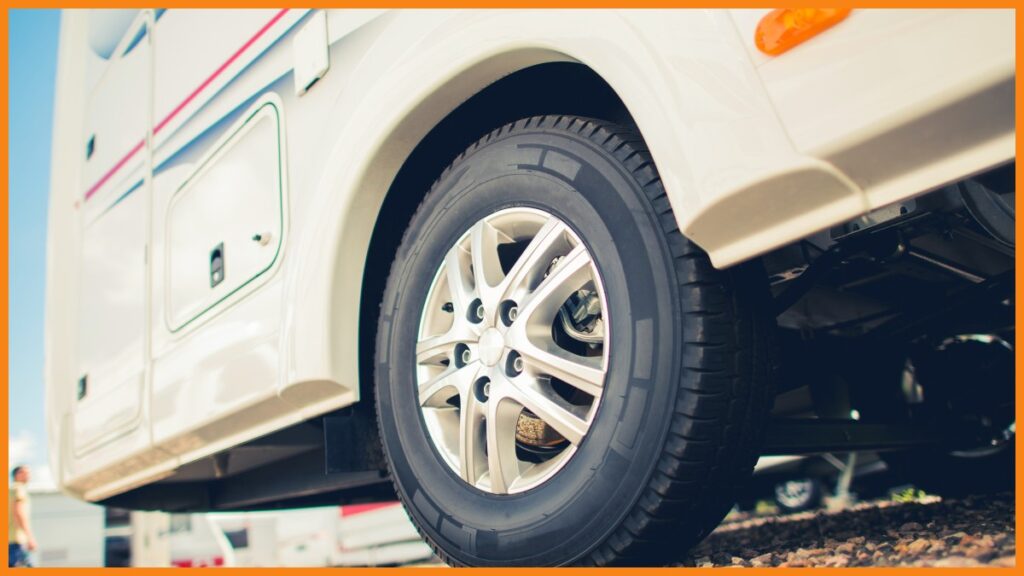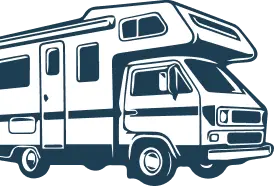
Your RV’s “foundation” isn’t the frame—it’s the tires. Get them right and road days feel smooth and safe. Get them wrong and you’re white-knuckling in crosswinds, watching temps creep up, and Googling trailer tires near me or Rv Mobile Repair on the shoulder.
Tires age out quietly. UV, heat, under-inflation, and overload chew through rubber long before the tread looks bad. Newer RVers often inherit older rubber, mix sizes or load ranges, or set PSI for an empty rig—then hit the highway in summer. That’s how vacations turn into blowouts and fender damage. The fix isn’t complicated; you just need a simple system.
What to Buy (so you don’t guess at the counter)
1) Start with the label: size, type & load
Look at your trailer’s data plate (usually near the front left side) and match:
- Type: Most travel trailers use ST (Special Trailer) tires. They have stiffer sidewalls to control sway and carry vertical load.
- Size example: ST205/75R14 = ST trailer tire, 205 mm width, 75 aspect ratio, radial, 14″ wheel.
- Load Range (C, D, E, etc.): Higher letters usually mean higher load capacity. Never go below the manufacturer’s spec.
Tip: When shopping camper tires near me, take a phone photo of the data plate and a sidewall close-up. That’s your cheat sheet.
2) Radial vs. Bias-ply (plain-English)
- Radial: Runs cooler on the highway, longer tread life, smoother tow. Great if you travel often.
- Bias-ply: Tougher sidewalls that tolerate rough surfaces and short, heavy hauls. Good for utility or off-pavement use.
3) Read the DOT date (age matters)
Find the DOT code on the sidewall. The last four digits = week + year (e.g., 2321 = 23rd week of 2021). If the tire is ~6–7 years old, plan replacement regardless of tread. If you see a three-digit code, that tire is ancient—replace now.
4) Speed rating & wheels
Many ST tires list a speed rating (often 65 mph unless marked otherwise). Respect it. Also check wheel ratings; your PSI is limited by the lower of tire or wheel specs.
Make Them Last (the habits that prevent blowouts)
5) Set PSI by weight, not guesses
Load the rig like you’re traveling (water, gear, people). Weigh each axle (ideally each wheel position), then set cold PSI using the tire maker’s load & inflation table. Keep PSI equal across an axle and never exceed tire or wheel limits.
6) Balance and rotate
Yes, balancing helps on trailers. It reduces vibration, heat, and odd wear—protecting bearings, suspension, and your rv trailer tires. Rotate if your wear pattern suggests it (many shops will advise at inspection).
7) Store smart: fight UV and heat
Use tire covers, park on boards/blocks (not hot asphalt), and choose shade when possible. UV and heat age rubber fast. Covers are cheap insurance for rv tyres.
8) Torque and TPMS
Before trips, torque lugs to spec. On the road, a TPMS (tire pressure monitoring system) gives early warnings for pressure loss or temperature spikes—easy save from a roadside disaster.
You can also read: How an RV Surge Protector Works and Why It’s Essential
Common Mistakes and easy fixes
- Under-inflation: The #1 heat builder. Fix: set cold PSI from load tables every travel morning.
- Overload: The rig’s GVWR and axle ratings aren’t suggestions. Fix: weigh it. Shift or remove weight.
- Mismatched sizes/load ranges: Sways, pulls, and runs hot. Fix: match the data plate (or step up in quality/load—not down).
- Old but “good-looking” tires: Rubber ages from the inside. Fix: trust the DOT date, not just the tread.
- Speeding: Tires have limits. Fix: cruise within your rating; your sidewalls will thank you.
5-Minute Pre-Trip Tire Routine
- Sight check: bulges, cracks, cords, or embedded screws.
- DOT date: anything near 6–7 years? Schedule rv tire replacement.
- PSI (cold): set from load tables for today’s load.
- Lug torque: confirm to axle spec.
- TPMS on: watch pressure/temperature as you drive.
- Speed discipline: honor the tire’s rating.
Real-World Proof
- St. George, UT: A couple searching st george rv tires for an annoying shimmy learned their left/right load was off by 300 lbs. A weigh-and-balance session plus correct PSI made the rig tow straight and run cooler.
- Inherited trailer: New owner saw “good tread,” but the DOT code showed 3818 (2018). They swapped to the best camper trailer tires in the correct load range, added light-colored covers, and drove a whole July trip with zero heat alarms.
- Weekend warrior: PSI set at home in winter, then summer hit. Sidewalls ran hot. A quick re-set using the load table at travel weight fixed it—no more blowouts, no more roadside searches for tires for a camper.
Quick Buyer’s Cheatsheet
- Type: ST for trailers; LT/P for tow vehicles only.
- Size/Load: Match the data plate; don’t downsize load range.
- Construction: Radial for highway miles; bias-ply for rough duty.
- DOT date: Replace around 6–7 years or at first sign of damage.
- PSI: Set cold from load tables; re-check on travel mornings.
- Extras that pay off: TPMS, covers, balancing, proper torque.
If you’ve been hunting trailer tires near me, camper tires, or rv tire replacement, let us make it simple. Our RV tire service team offers:
- Tire inspections & size/load confirmation
- Mobile RV tire replacement
- Wheel balancing for trailers
- TPMS supply & setup
- Trip-ready PSI setup using manufacturer load tables
Ready to roll with confidence? Book a quick RV Tire Health Check today and hit the road feeling safe, steady, and road-trip happy.
FAQ
RV/trailer tires (often ST) have stiffer sidewalls to control sway and carry vertical loads. Passenger car tires aren’t designed for trailer dynamics.
Use the tire maker’s load & inflation table for your real, loaded weight—set PSI cold. Never exceed tire or wheel limits.
Age out is real. Plan inspections yearly and consider replacement around the 6–7 year mark even with decent tread.
Balancing reduces vibration and heat, helping bearings and suspension. It’s inexpensive and worth it.
Yes. UV and heat age rubber. Covers extend life and are cheap peace of mind for camper tires and rv tyres.

